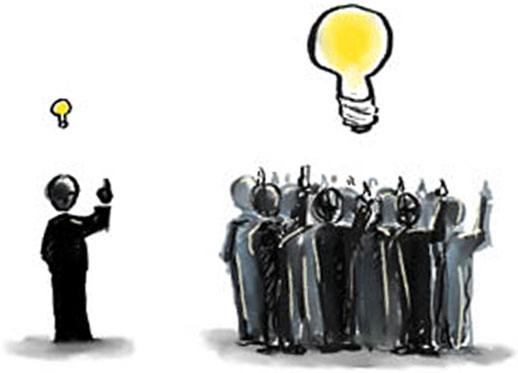
I’m a history-student so my mind immediately goes to museums, exhibitions and art-collections when I think of the word curator but this term is being used in a much broader context. It’s being used in fashion, the business world, the entertainment industry… In this digital age everyone curates their own lives online.
“A new spin. Are DJs, rappers and bloggers ‘curators” is an article by Elizabeth Schlatter. The title already says a lot. She examines the changing significance of the word curator and goes deeper into crowdsourcing and digital curating. She finds that the meaning of the word curator has become so broad, everyone claims it. Of course professional curators aren’t always happy about this evolution because they think it might devaluate their job. The word curator implies prestige and professionalism, it makes you sound like a specialist which of course makes it a very appealing term. Momentarily there is a lot of discussion about the value of a diploma in the world of curating. This is a discussion that came up mainly because of the new developments around crowdsourcing.
Crowdsourcing is a fairly new way of getting the public involved. It’s a shared responsibility between the curator and the public to be creative. In this way the public might co-decide what’s on display in museums, what’s on the websites and many different things. It’s a new way of interaction, because the crowd is involved in decision-making. They’re taking over the function of curator.
Of course this brings a lot of controversy and discussion between curators. Where to draw a line between amateurs and professionals? Why even bother to pay a curator when you can get hundreds of people to do the work for you voluntarily? Professional curators now feel like they need to protect their jobs, the jobs for which they have an education and the experience. Peter Eleey, a curator of the MoMA, tells in an article that the idea of crowdsourcing isn’t entirely played out correctly. I can see where he’s coming from. As a curator you have your diploma for a reason. You are the one who can tell a story through an exhibition, this is the reason you’ve been hired. You not only organize and edit, you are very involved with the collection. As a professional curator you study, you publish, you add and you make recommendations about “your” collection. If you let the crowd decide what needs to be exposed in a museum via – for example – a poll, you might lose the whole story the museum tried to tell. This can cause museums to lose their original functions or missions. There is a certain danger in getting the public involved, but I think that if professional curators overlook the processes and get involved it can create a wonderful experience for both museums and the public.

Crowdsourcing can happen in many different ways; you don’t necessarily have to let the public make an exhibition. You can get them involved via websites, social media, workshops etc. I do think there is a difference between a museum of art and a history museum. It’s harder for a museum that tries to tell an historic story, to get the public involved without losing the narrative of the museum. There is a certain context needed when you’re trying to tell a historical tale. On the other hand, it’s nice for curators to step out of their comfort zone and get inspired by what people really want on display. I’m more in favour of a digital way of crowdsourcing, instead of the public actually changing the format of the museum.
The Rijksmuseum is, in my opinion, a good example of crowdsourcing. The museum has given its website-visitors the opportunity to compose their own Rijksstudio in which you can add all the artwork from the Rijksmuseum into your own little studio. It’s always available, you get extra information and when you plan a visit you can use this as your guide to your own favourite works of art. Something like this can easily work in a museum that is solely based on history as well. In this way you get the interaction with your public, you know what they like, they can give opinions but you don’t have to change the whole museum with the risk of changing its goal or storyline.
Crowdsourcing can be a great thing, when used right. I think the professional curators and people interested in curating can work perfectly together, they can complement each other. The professional curator’s job seems nevertheless still necessary to guide this in the right direction.
Sofie